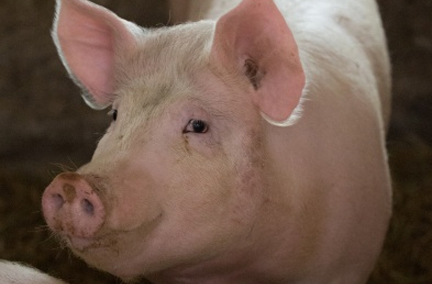
SHIC, launched in 2015 with Pork Checkoff funding, continues to focus efforts on prevention, preparedness, and response to novel and emerging swine disease for the benefit of US swine health. As a conduit of information and research, SHIC encourages sharing of its publications and research. Forward, reprint, and quote SHIC material freely. SHIC is funded by America’s pork producers to fulfill its mission to protect and enhance the health of the US swine herd. For more information, visit http://www.swinehealth.org or contact Dr. Sundberg at [email protected].

Further Mitigation of Feed Import Risks Identified as Priority Area of Focus
Ames, Iowa, Sept. 7, 2021 – A new year-long study to identify U.S. pork industry gaps in biosecurity defenses against foreign animal diseases, funded by the Pork Checkoff and the Swine Health Information Center (SHIC), found no major areas have been overlooked in efforts to prevent the introduction of African swine fever (ASF) to the United States. With ASF confirmed in the Dominican Republic, the first time it has been in the western hemisphere in 40 years, this work provides reassurance the U.S. pork industry and government agencies have identified the major routes of potential domestic introduction. The study, conducted by EpiX Analytics, LLC, reinforced the importance of continued on-farm biosecurity diligence for known pathways and identified feed and feed ingredient imports risks as a critical opportunity to bolster defenses against ASF.
“This EpiX review provided a third-party evaluation of potential gaps in national biosecurity that could put the U.S. swine industry at risk of a viral introduction. It is reassuring that the review did not find any gaps that we were not already aware of and working to address,” says Harry Snelson, DVM, executive director, American Association of Swine Veterinarians (AASV).
In total, EpiX considered eight FAD entry pathways: legal import of live animals, illegal import of live animals, import of pork products, import of feed and feed ingredients, fomites associated with international movements, international movement of people, transboundary movements of wildlife and vectors, and intentional and accidental release. Gaps were prioritized using a defined set of criteria. Extensive literature review along with input from an advisory group made up of representatives of academia, industry, and government were considered in EpiX process.
“EpiX’s results help direct further actions to protect the U.S. swine herd. Now we continue to collaboratively build on the efforts made to date and remain vigilant,” says Paul Sundberg, DVM, PhD, DACVPM, executive director, Swine Health Information Center (SHIC). “The study identified and looked into the vulnerabilities of bringing FADs into the U.S. Closing those pathways as best as possible along with the partnership of the producers’ on-farm biosecurity implementation to ensure FADs don’t get to pigs, if they are able to slip through, will ensure the continued safety of the U.S. swine herd.”
Pork Industry Committed to Continuous Improvement
“While we are encouraged by the report’s overall assessment of the industry’s progress in reducing the risk of ASF introduction into the country, we know that there’s always more work to be done,” says Patrick Webb, DVM, acting chief veterinarian for the National Pork Board. “We must continue to work together to find real-world solutions for producers and their suppliers to implement that can help keep our national herd free of this costly virus.”
It is reassuring to confirm the U.S. pork industry, along with government agencies, has done a good job to date to identify potential pathways for introduction and biosecurity protocols to prevent introduction. For example, the vulnerability of illegal import of meat is being addressed by U.S. Customs and Border Protection along with USDA programs to decrease the risk. The EpiX work also validated the industry’s assumption that there is still vulnerability from imported feed and feed ingredients, thus encouraging continued scrutiny. Other vulnerabilities, such as feral swine and illegal or out-of-regulatory-compliance garbage feeding, were also identified by the study as areas for the pork industry to continue working to address.
“Knowing we have accurately identified the potential ASF pathways allows us to sharpen our focus on further strengthening biosecurity defenses in the right places,” said Dr. Liz Wagstrom, the National Pork Producer Council’s (NPPC) chief veterinarian. “These efforts include ongoing work by the Cooperative Feed Risk Task Force – with representation from the USDA, FDA, industry and academia – to inform feed purchasing, holding time and treatment practices.”
The study’s findings were presented to the AASV, NPB, NPPC and SHIC. These pork organizations continue to work collaboratively to prevent ASF, and other foreign animal diseases, from reaching domestic swine herds. This joint project reflects the commitment these groups have to serve and inform U.S. pork producers and protect the health of the domestic swine herd.

Last month, the Swine Health Information Center (SHIC) offered a reminder for continued reporting of traveler experiences while going through customs entering the US. That morning, a report of international travelers not being diverted to Customs and Border Protection agriculture specialists for secondary screening after they indicated on their Customs form that they had had animal contact at their African swine fever (ASF) and foot-and-mouth disease (FMD) endemic destination was shared. After getting this report, a Customs and Border Protection contact immediately responded saying, “…flights from that area of the world should be a tactical focus and there will be follow up with the agents at that airport.”
International travelers returning to the US, or those arriving from other countries, after visiting a farm or being in contact with animals in a country (or countries) with African swine fever (ASF), or any other foreign animal disease, should declare this information to US Customs and Border Protection (CBP) via written form, airport kiosk, or verbally.
If you are NOT diverted for secondary screening after declaring you have been on a farm or in contact with animals in an ASF or other foreign animal disease positive nation, or know of someone with this status, please email the following to [email protected]:
Dr. Sundberg aggregates this information so SHIC, the American Association of Swine Veterinarians, National Pork Board, and National Pork Producers Council can share it with CBP to help identify areas for continued focus.

The atypical porcine pestivirus (APPV) fact sheet has been updated in the Swine Health Information Center (SHIC) Swine Disease Fact Sheet Library. As part of SHIC’s mission to protect the health of the US swine herd, providing guidance and resources for producers, practitioners, and diagnosticians who are on the front lines of swine health concerns is an ongoing effort. This updated APPV fact sheet captures the latest information available on this swine health concern.
APPV was identified in the US in 2015 and is genetically recognizable from other pestiviruses including Bungowannah virus, which emerged in Australia in 2003. APPV is widely found, but its clinical relevance is poorly understood. To date, APPV has been associated only with congenital tremors (CT) in newborn pigs. In addition to muscle spasms, posterior paresis and splayleg can be seen. Litters from gilts are most commonly affected. In litters with CT, morbidity ranges from 0–100%. There is no treatment for APPV and no commercial vaccine.
Based on current knowledge of APPV, prevention and control strategies that might be useful include acclimatization of replacement gilts to ensure APPV exposure before breeding, testing of semen for the presence of APPV RNA prior to artificial insemination, and feedback on farms with clinical CT cases, until an effective commercial vaccine is available. Vertical transmission is associated with the development of CT. Horizontal transmission also occurs, but infection seems to be transient, and piglets do not develop clinical signs of disease.
More information is needed on the epidemiology, transmission, and pathogenesis of APPV to assess its impact on the swine industry and develop preventive measures.

Reports of difficult cases of colibacillosis that have been associated with the F-18 fimbrial antigen and leading to gut edema disease have been increasing. With up to 100% morbidity and 20% mortality on some sites, the Swine Health Information Center (SHIC) and the American Association of Swine Veterinarians (AASV) responded with a webinar, conducted by the ISU Swine Medicine Education Center, on September 28 to hear directly from practitioners and a diagnostician involved in these outbreaks. In addition to the clinical signalment of the disease, the webinar included outbreak videos, postmortem findings, diagnostic workups, management successes and challenges, and ISU veterinary diagnostic lab historical data analyses. The webinar was attended by 139 participants from Austria, Canada, the Czech Republic, Germany, the Netherlands, Spain and the United States.
New Fashion Pork veterinarian, Dr. Deb Murray opened the webinar presenting her experiences with outbreaks occurring as early as immediately after placement of newly weaned pigs to as long as 4 weeks later. Showing sequential videos of pigs during an outbreak along with postmortem and diagnostic results, of note was the involvement of multiple virulence factors consistent with enterotoxigenic E. coli strains, including shiga toxin, and lack of response to an F18 vaccine that had previously been effective. Compounding factors included poor water quality and, typically, lack of total depopulation of sites before placing new pigs.
Dr. Kurt Kuecker, the Hanor Company, talked about outbreaks in his systems that included a sudden 2-3% mortality spike within 24 hours along with 20-60% morbidity occurring 20-30 days post placement, which is 5-7 days after shifting diets from a complex pelleted ration to a corn/soy ground feed ration. Diagnostic results included colibacillosis with multiple virulence toxins and multidrug resistance. Managing the diets to ensure that all pigs got their entire, sequenced feed budget was found to be an important factor in prevention of the outbreaks.
In analysis of ISU veterinary diagnostic data from 2017 to the present, Dr. Drew Magstadt, clinical associate professor in the diagnostic laboratory, found trends that showed a decrease in K88-associated disease but a corresponding increase in F18-associated cases over that time. At the same time, the data showed an obvious increase in some enterotoxins in F18+ cases along with a trend toward resistance to common enteric antimicrobials often used for treatment. Dr. Magstadt reminded the participants that the best opportunity for meaningful diagnostic results includes selecting pigs that are representative of the observed clinical disease, providing a good case history and submitting multiple tissues, including several sections of intestine, colon, liver and mesenteric lymph nodes, and brain/whole heads if edema disease is suspected.
SHIC, launched in 2015 with Pork Checkoff funding, continues to focus efforts on prevention, preparedness, and response to novel and emerging swine disease for the benefit of US swine health. As a conduit of information and research, SHIC encourages sharing of its publications and research. Forward, reprint, and quote SHIC material freely. SHIC is funded by America’s pork producers to fulfill its mission to protect and enhance the health of the US swine herd. For more information, visit http://www.swinehealth.org or contact Dr. Sundberg at [email protected].

This month’s Domestic Swine Disease Monitoring Report now includes the Ohio Animal Disease and Diagnostic Laboratory (OH ADDL) joining the network. A similar overall level of detection for porcine reproductive and respiratory syndrome virus (PRRSV) and enteric coronavirus occurred when compared to August. Even though the levels of detection were similar, a trend for an increase in detection of PRRSV and porcine epidemic diarrhea virus (PEDV) in the age category wean-to-market was observed in September. In the podcast, the SDRS team welcomes, and hosts talk with, the OH ADDL team.

In the October Global Swine Disease Monitoring Report, read about African swine fever (ASF) being diagnosed in Haiti, the first confirmed detection in 37 years. The report also includes a Dominican Republic field visit report with first-hand observations on the ASF situation there. A new foot-and-mouth (FMD) strain, serotype) has been detected for the first time in Namibia. And learn more about Taiwan’s moves to tighten entry point checks.
Copyright 2025 | Swinehealth.org | Website by Heartland Marketing Group